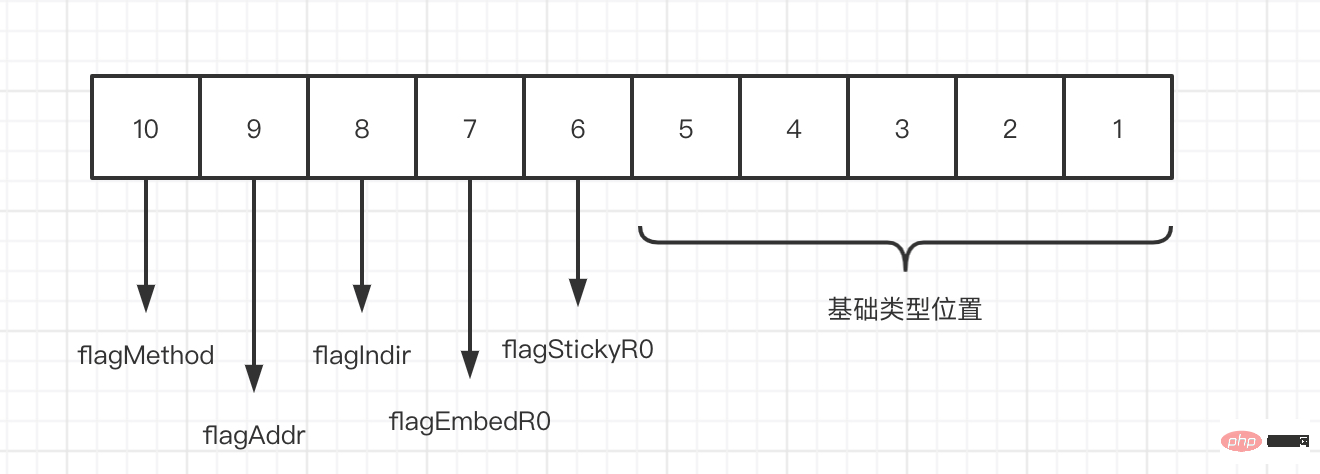What are CanSet, CanAddr?
The following column will introduce to you what CanSet and CanAddr are from the golang tutorial column. I hope it will be helpful to friends in need!

An article to understand what CanSet and CanAddr are?
What is settable (CanSet)
First of all, we need to clarify that settable is for reflect.Value. To convert an ordinary variable into reflect.Value, you need to use reflect.ValueOf() to convert it first.
So why is there such a "settable" method? For example, the following example:
var x float64 = 3.4v := reflect.ValueOf(x)fmt.Println(v.CanSet()) // false
All function calls in golang are value copies, so when calling reflect.ValueOf, an x has been copied and passed in, and the v obtained here is an x The value of the copy. So at this time, we want to know whether I can set the x variable here through v. We need a method to help us do this: CanSet()
However, it is very obvious that since we are passing a copy of x, the value of x cannot be changed here at all. What is shown here is false.
So what if we pass the address of x into it? Here's an example:
var x float64 = 3.4v := reflect.ValueOf(&x)fmt.Println(v.CanSet()) // false
We pass the address of the x variable to reflect.ValueOf. It should be CanSet. But one thing to note here is that v here points to the pointer of x. So the CanSet method determines whether the pointer of x can be set. Pointers definitely cannot be set, so false is still returned here.
Then what we need to judge from the value of this pointer is whether the element pointed to by this pointer can be set. Fortunately, reflect provides the Elem() method to obtain the "element pointed to by the pointer".
var x float64 = 3.4v := reflect.ValueOf(&x)fmt.Println(v.Elem().CanSet()) // true
Finally returns true. But there is a prerequisite when using Elem(). The value here must be reflect.Value converted from a pointer object. (Or reflect.Value for interface object conversion). This premise is not difficult to understand. If it is an int type, how can it have an element it points to? Therefore, be very careful about this when using Elem, because if this prerequisite is not met, Elem will directly trigger a panic.
After judging whether it can be set, we can make the corresponding settings through the SetXX series of methods.
var x float64 = 3.4v := reflect.ValueOf(&x)if v.Elem().CanSet() {
v.Elem().SetFloat(7.1)}fmt.Println(x)More complex types
For complex slice, map, struct, pointer and other methods, I wrote an example:
package mainimport (
"fmt"
"reflect")type Foo interface {
Name() string}type FooStruct struct {
A string}func (f FooStruct) Name() string {
return f.A}type FooPointer struct {
A string}func (f *FooPointer) Name() string {
return f.A}func main() {
{
// slice
a := []int{1, 2, 3}
val := reflect.ValueOf(&a)
val.Elem().SetLen(2)
val.Elem().Index(0).SetInt(4)
fmt.Println(a) // [4,2]
}
{
// map
a := map[int]string{
1: "foo1",
2: "foo2",
}
val := reflect.ValueOf(&a)
key3 := reflect.ValueOf(3)
val3 := reflect.ValueOf("foo3")
val.Elem().SetMapIndex(key3, val3)
fmt.Println(val) // &map[1:foo1 2:foo2 3:foo3]
}
{
// map
a := map[int]string{
1: "foo1",
2: "foo2",
}
val := reflect.ValueOf(a)
key3 := reflect.ValueOf(3)
val3 := reflect.ValueOf("foo3")
val.SetMapIndex(key3, val3)
fmt.Println(val) // &map[1:foo1 2:foo2 3:foo3]
}
{
// struct
a := FooStruct{}
val := reflect.ValueOf(&a)
val.Elem().FieldByName("A").SetString("foo2")
fmt.Println(a) // {foo2}
}
{
// pointer
a := &FooPointer{}
val := reflect.ValueOf(a)
val.Elem().FieldByName("A").SetString("foo2")
fmt.Println(a) //&{foo2}
}}If you can understand the above example, then you basically understand the CanSet method.
You can pay special attention to the fact that map and pointer do not need to pass the pointer to reflect.ValueOf when they are modified. Because they are pointers themselves.
So when calling reflect.ValueOf, we must be very clear about the underlying structure of the variable we want to pass. For example, map actually transfers a pointer, and we don't need to point it anymore. As for slice, what is actually passed is a SliceHeader structure. When we modify Slice, we must pass the pointer of SliceHeader. This is something we often need to pay attention to.
CanAddr
You can see in the reflect package that in addition to CanSet, there is also a CanAddr method. What's the difference between the two of them?
The difference between the CanAddr method and the CanSet method is that for some private fields in the structure, we can get its address, but we cannot set it.
For example, the following example:
package mainimport (
"fmt"
"reflect")type FooStruct struct {
A string
b int}func main() {
{
// struct
a := FooStruct{}
val := reflect.ValueOf(&a)
fmt.Println(val.Elem().FieldByName("b").CanSet()) // false
fmt.Println(val.Elem().FieldByName("b").CanAddr()) // true
}}So, CanAddr is a necessary and insufficient condition for CanSet. A Value if CanAddr, not necessarily CanSet. But if a variable canSet, it must be CanAddr.
Source code
Assuming we want to implement this Value element CanSet or CanAddr, we will most likely use the mark bit mark. This is indeed the case.
Let’s take a look at the structure of Value first:
type Value struct {
typ *rtype
ptr unsafe.Pointer
flag}What should be noted here is that it is a nested structure with a flag nested inside it, and the flag itself is a uintptr.
type flag uintptr
This flag is very important. It can express not only the type of the value, but also some meta-information (such as whether it is addressable, etc.). Although flag is of uint type, it is represented by bit marks.
First of all, it needs to represent the type. There are 27 types in golang:
const ( Invalid Kind = iota Bool Int Int8 Int16 Int32 Int64 Uint Uint8 Uint16 Uint32 Uint64 Uintptr Float32 Float64 Complex64 Complex128 Array Chan Func Interface Map Ptr Slice String Struct UnsafePointer)
所以使用5位(2^5-1=63)就足够放这么多类型了。所以 flag 的低5位是结构类型。
第六位 flagStickyRO: 标记是否是结构体内部私有属性
第七位 flagEmbedR0: 标记是否是嵌套结构体内部私有属性
第八位 flagIndir: 标记 value 的ptr是否是保存了一个指针
第九位 flagAddr: 标记这个 value 是否可寻址
第十位 flagMethod: 标记 value 是个匿名函数

其中比较不好理解的就是 flagStickyRO,flagEmbedR0
看下面这个例子:
type FooStruct struct {
A string
b int}type BarStruct struct {
FooStruct}{
b := BarStruct{}
val := reflect.ValueOf(&b)
c := val.Elem().FieldByName("b")
fmt.Println(c.CanAddr())}这个例子中的 c 的 flagEmbedR0 标记位就是1了。
所以我们再回去看 CanSet 和 CanAddr 方法
func (v Value) CanAddr() bool {
return v.flag&flagAddr != 0}func (v Value) CanSet() bool {
return v.flag&(flagAddr|flagRO) == flagAddr}他们的方法就是把 value 的 flag 和 flagAddr 或者 flagRO (flagStickyRO,flagEmbedR0) 做“与”操作。
而他们的区别就是是否判断 flagRO 的两个位。所以他们的不同换句话说就是“判断这个 Value 是否是私有属性”,私有属性是只读的。不能Set。
应用
在开发 collection (https://github.com/jianfengye/collection)库的过程中,我就用到这么一个方法。我希望设计一个方法 func (arr *ObjPointCollection) ToObjs(objs interface{}) error,这个方法能将 ObjPointCollection 中的 objs reflect.Value 设置为参数 objs 中。
func (arr *ObjPointCollection) ToObjs(objs interface{}) error {
arr.mustNotBeBaseType()
objVal := reflect.ValueOf(objs)
if objVal.Elem().CanSet() {
objVal.Elem().Set(arr.objs)
return nil }
return errors.New("element should be can set")}使用方法:
func TestObjPointCollection_ToObjs(t *testing.T) {
a1 := &Foo{A: "a1", B: 1}
a2 := &Foo{A: "a2", B: 2}
a3 := &Foo{A: "a3", B: 3}
bArr := []*Foo{}
objColl := NewObjPointCollection([]*Foo{a1, a2, a3})
err := objColl.ToObjs(&bArr)
if err != nil {
t.Fatal(err)
}
if len(bArr) != 3 {
t.Fatal("toObjs error len")
}
if bArr[1].A != "a2" {
t.Fatal("toObjs error copy")
}}总结
CanAddr 和 CanSet 刚接触的时候是会有一些懵逼,还是需要稍微理解下 reflect.Value 的 flag 就能完全理解了。
The above is the detailed content of What are CanSet, CanAddr?. For more information, please follow other related articles on the PHP Chinese website!

Hot AI Tools

Undresser.AI Undress
AI-powered app for creating realistic nude photos

AI Clothes Remover
Online AI tool for removing clothes from photos.

Undress AI Tool
Undress images for free

Clothoff.io
AI clothes remover

AI Hentai Generator
Generate AI Hentai for free.

Hot Article

Hot Tools

Notepad++7.3.1
Easy-to-use and free code editor

SublimeText3 Chinese version
Chinese version, very easy to use

Zend Studio 13.0.1
Powerful PHP integrated development environment

Dreamweaver CS6
Visual web development tools

SublimeText3 Mac version
God-level code editing software (SublimeText3)

Hot Topics
 1385
1385
 52
52
 How to safely read and write files using Golang?
Jun 06, 2024 pm 05:14 PM
How to safely read and write files using Golang?
Jun 06, 2024 pm 05:14 PM
Reading and writing files safely in Go is crucial. Guidelines include: Checking file permissions Closing files using defer Validating file paths Using context timeouts Following these guidelines ensures the security of your data and the robustness of your application.
 How to configure connection pool for Golang database connection?
Jun 06, 2024 am 11:21 AM
How to configure connection pool for Golang database connection?
Jun 06, 2024 am 11:21 AM
How to configure connection pooling for Go database connections? Use the DB type in the database/sql package to create a database connection; set MaxOpenConns to control the maximum number of concurrent connections; set MaxIdleConns to set the maximum number of idle connections; set ConnMaxLifetime to control the maximum life cycle of the connection.
 How to use gomega for assertions in Golang unit tests?
Jun 05, 2024 pm 10:48 PM
How to use gomega for assertions in Golang unit tests?
Jun 05, 2024 pm 10:48 PM
How to use Gomega for assertions in Golang unit testing In Golang unit testing, Gomega is a popular and powerful assertion library that provides rich assertion methods so that developers can easily verify test results. Install Gomegagoget-ugithub.com/onsi/gomega Using Gomega for assertions Here are some common examples of using Gomega for assertions: 1. Equality assertion import "github.com/onsi/gomega" funcTest_MyFunction(t*testing.T){
 Golang framework vs. Go framework: Comparison of internal architecture and external features
Jun 06, 2024 pm 12:37 PM
Golang framework vs. Go framework: Comparison of internal architecture and external features
Jun 06, 2024 pm 12:37 PM
The difference between the GoLang framework and the Go framework is reflected in the internal architecture and external features. The GoLang framework is based on the Go standard library and extends its functionality, while the Go framework consists of independent libraries to achieve specific purposes. The GoLang framework is more flexible and the Go framework is easier to use. The GoLang framework has a slight advantage in performance, and the Go framework is more scalable. Case: gin-gonic (Go framework) is used to build REST API, while Echo (GoLang framework) is used to build web applications.
 How to save JSON data to database in Golang?
Jun 06, 2024 am 11:24 AM
How to save JSON data to database in Golang?
Jun 06, 2024 am 11:24 AM
JSON data can be saved into a MySQL database by using the gjson library or the json.Unmarshal function. The gjson library provides convenience methods to parse JSON fields, and the json.Unmarshal function requires a target type pointer to unmarshal JSON data. Both methods require preparing SQL statements and performing insert operations to persist the data into the database.
 How to find the first substring matched by a Golang regular expression?
Jun 06, 2024 am 10:51 AM
How to find the first substring matched by a Golang regular expression?
Jun 06, 2024 am 10:51 AM
The FindStringSubmatch function finds the first substring matched by a regular expression: the function returns a slice containing the matching substring, with the first element being the entire matched string and subsequent elements being individual substrings. Code example: regexp.FindStringSubmatch(text,pattern) returns a slice of matching substrings. Practical case: It can be used to match the domain name in the email address, for example: email:="user@example.com", pattern:=@([^\s]+)$ to get the domain name match[1].
 Transforming from front-end to back-end development, is it more promising to learn Java or Golang?
Apr 02, 2025 am 09:12 AM
Transforming from front-end to back-end development, is it more promising to learn Java or Golang?
Apr 02, 2025 am 09:12 AM
Backend learning path: The exploration journey from front-end to back-end As a back-end beginner who transforms from front-end development, you already have the foundation of nodejs,...
 How to use predefined time zone with Golang?
Jun 06, 2024 pm 01:02 PM
How to use predefined time zone with Golang?
Jun 06, 2024 pm 01:02 PM
Using predefined time zones in Go includes the following steps: Import the "time" package. Load a specific time zone through the LoadLocation function. Use the loaded time zone in operations such as creating Time objects, parsing time strings, and performing date and time conversions. Compare dates using different time zones to illustrate the application of the predefined time zone feature.




